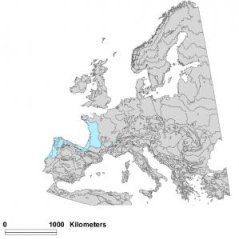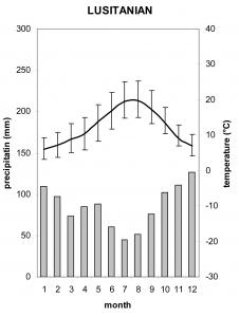
Lusitenean (LUS)
The most characteristic in the environmental zone Lusitanian is the relatively humid Atlantic climate with Mediterranean-like distribution of precipitation within a year (maximum in winter). The growing season lasts 353 days (345-365), the sum of temperatures above +10° is 4749°C (4462°-5302°).

The relief is very diverse, varying from the lowlands of Les Grandes Landes to the low mountain ranges of Galicia and Serra da Estrela. Cordiliera Cantabrica is Hercynian in the west and the folded structure of the mantle of Epi-Palaeozoic platform in the east. The west of Cordiliera Cantabrica is dominated by Ordovician, Silurian (west) and Carboniferous (east) deposits. Its Eastern ranges are built up by Cretaceous formations. West Pyrénées are dominated by Triassic, Jurassic, Ordovician and Silurian (west), Devonian, Carboniferous, Permian and Triassic formations (east). Beira Litoral and West of Biscayans lie on the mantle of Epi-Palaeozoic platforms; Galician Mountains develop on the Hercynian structures, and the east of Biscayans belongs to the Alpine orogenic belt. The uplands of Minho-Beira Baixo are underlaid by Archaean formations and Palaeozoic acidic and intermediate magmatic rocks; the Cantabrian coast is dominated by Archaean formations on the West, and by Ordovician, Silurian and Carboniferous on the East. Les Grandes Landes are mainly Pleistocene. Serpentine rocks occur on several places.

The Quaternary complex of is dominated by diluvial-colluvial, on the plains mainly by eluvial-deluvial deposits. The north of Beira Litoral is dominated by Holocene and undifferentiated Neocene. The Galician Mountains are buit up by Palaeozoic acidic and intermediate magmatic rocks, and Biscayans by Cretaceous deposits.
The potential vegetation consists of deciduous forests; flora is dominated by Atlantic species, rather than Mediterranean. A large proportion of land is used for rainfed crops. The main agricultural products are wheat and wine. The soil is poor, so production is rather low. It is the area of the southern European heathlands; grazing with sheep is one of the traditional forms of agriculture.
